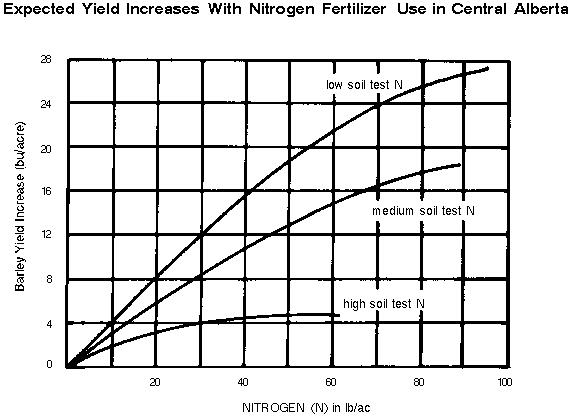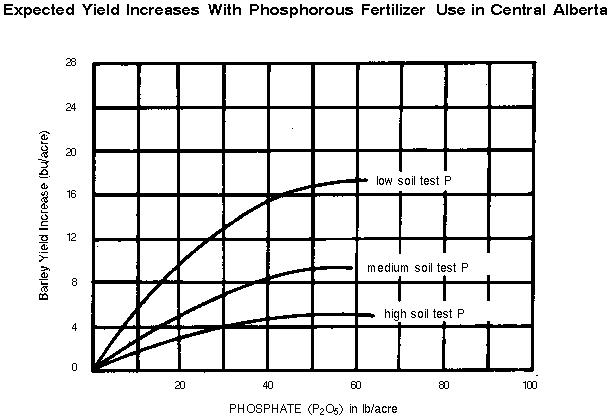| | General information | Fertilizing barley for silage and high moisture grain | Fertilizing barley for dry-feed | Fertilizing barley grown for malt
General Information
Few crops respond as well or as readily to applied fertilizers as does barley. A fertilizer management program that will optimize not only plant and grain yield, but also grain quality, must be the objective of all good producers. The kind and amount of fertilizer applied should be governed by the intended end use for the barley. Barley may be used for silage and high moisture grain, dry-feed grain, or for malting.
Did you know that:
- Low soil moisture restricts the benefits of applied nitrogen fertilizers on barley yields, but the full effect of favorable moisture conditions cannot be realized until adequate nitrogen has been provided to the barley.
- Maintaining a good supply of available phosphorus to a barley crop is a means of protecting that crop against the adverse effects of above- or below- optimum soil temperatures.
- Root rot is generally less severe in barley that is well supplied with available phosphorus and nitrogen than in inadequately fertilized barley.
- Barley plants continue to use available nitrogen even after the requirements for yield are fulfilled, and as a result, grain protein increases.
- Application of excessive amounts of nitrogen fertilizer will generally produce barley of poor or unacceptable malting quality.
- The application of sulfur to sulfur-deficient soils results in a more efficient utilization of applied nitrogen and phosphate fertilizer and advances maturity. The major symptom of sulfur deficiency is when new leaves are more yellow than older leaves. Deficient soils are usually coarse textured, low organic soils where there is sufficient moisture to leach the sulfate from the root zone.
- Broadcast-applied nitrogen fertilizer will stimulate the growth of wild oat seedlings almost as much as it does that of barley, so be prepared to control those wild oats.
- Barley usually responds better to applied nitrogen fertilizer when there is also enough available phosphorus present, and vice versa. A proper balance needs to be maintained.
- Potassium is important for straw strength and proper levels will help reduce lodging.
- It is important to have adequate phosphorus close to the germinating seed especially in cold slow growing conditions. Large amount of the phosphorus intake occurs in the very early stages of growth and needs to be close to be available to the young seedling.
- 3-6 days earlier maturity can be obtained in soils with proper levels of all nutrients, especially phosphorus.
- Copper has increasingly been recognized as a deficient nutrient in many Alberta soils. Large yield increases can be achieved by adding copper fertilizers to these soils. Copper deficieny is often found in high organic, coarse textured soils.
Survey results show that top producers are more aware of their soil condition, i.e. fertility level, pH, and organic matter content than the low producers. With this information, the top producer could then determine how much and what nutrients to apply to optimize yield.
Fertilizing Barley for Silage and High Moisture Grain
Where barley is to be harvested as silage, the grower must adjust his fertilizer program to produce the maximum amount of plant material. For high moisture grain, short straw and high grain yield is desirable. Usually such crops require some phosphorus, as well as heavy applications of nitrogen fertilizer, which may delay maturity. On selected soils, some copper, sulphur and potassium may also be required depending on soil test results.
Fertilizing Barley for Dry-Feed
High yields of excellent quality feed grain are most readily produced on soils that are well supplied, either naturally or through applied fertilizer, with all of the essential plant nutrients. The nutrients must be supplied in a balanced form so that none will limit growth. Yield will be determined by the most limiting factor of growth. In most cases, the most limiting factor to production is moisture. Research in central Alberta has shown how yields increase when additional units of nitrogen are applied and normal rainfall is received. The addition of phosphorus will also lead to yield increases in central Alberta.


Fertilizing Barley Grown for Malt
Growers of malting barley must obtain high yields of well-matured grain of desired quality. The grain must be relatively low in protein content and have plump kernels, high in carbohydrates. Growers must be prepared to fertilize adequately with phosphates and other needed nutrients but must not supply an excess of nitrogen. There is less chance of providing an excessive supply of nitrogen to an otherwise properly nourished healthy crop that will produce high yields, than to an undernourished crop which usually produces mediocre or low yields. When barley is seeded early, more nitrogen can be applied. Early seeded barley uses nitrogen for yield rather than increasing its protein content. Droughty conditions during the summer can lead to excessive protein in the grain. |
|